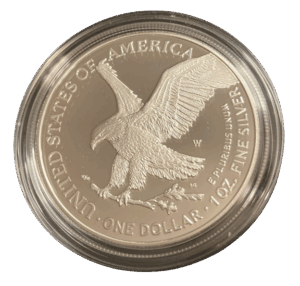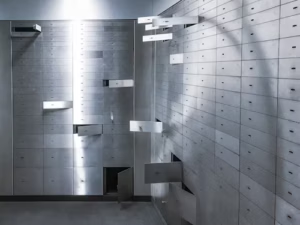How To Store Silver Coins
Posted on — Leave a commentSilver coins serve as both valuable investments and prized collectibles, but a single storage mistake can destroy decades of careful collecting. Without proper storage and handling, silver coins face serious threats from tarnishing, humidity damage, and scratches or surface wear. Improper methods can permanently reduce a coin’s value, sometimes by hundreds or thousands of dollars. This comprehensive guide provides proven solutions for how to store silver bullion coins, preserve your collection’s condition and maximize its long-term value.
Why Proper Storage Matters
Understanding silver’s unique chemical properties is essential for any serious collector or investor. Silver behaves differently to other metals when exposed to air and moisture, requiring specific storage approaches to maintain its condition and value.
Does silver rust or just tarnish?
A common misconception is that silver can rust like iron or steel. The question “Does silver rust?” has a clear answer: no. Silver does not rust because it contains no iron, which is required for the oxidation process that creates rust. However, the question “Does silver tarnish?” is a different matter entirely. Silver undergoes a process called tarnishing when it reacts with sulfur compounds in the air to form silver sulfide. This chemical reaction creates the characteristic dark, discolored coating that can dramatically affect a coin’s appearance and market value. Pure silver is less prone to tarnishing than sterling silver, but even the finest silver coins will eventually show signs of sulfur exposure without proper protection.
Impact of Environmental Factors
Humidity, air exposure, and temperature all play important roles in silver tarnishing. High humidity can accelerate tarnishing by creating conditions that allow sulfur compounds in the air to react more readily with silver surfaces. Air exposure is equally problematic, as everyday air contains sulfur compounds from pollution, household products, and natural sources. However, research shows that temperature plays a more significant role than humidity alone – sulfur vapor pressure increases at higher temperatures, accelerating the tarnishing process.
Contact with non-archival materials poses another serious threat. Cardboard, certain plastics, rubber, and adhesives release sulfur compounds that can concentrate around stored coins. Even materials like wood and paper can contain chemicals that promote tarnishing. Fingerprints and skin oils transfer salt and moisture that create localized corrosion, leaving permanent marks on coin surfaces.
Best Methods for Storing Silver Coins
Protecting your silver coin investment requires choosing the right storage methods and materials. The key is creating barriers between your coins and the environmental factors that cause tarnishing while ensuring easy access for viewing and handling when necessary.
Click here to see how one collector safely stores his silver collection using proven methods.
Airtight Containers and Capsules
Airtight storage represents the gold standard for silver coin preservation, ideal for preventing air exposure that leads to tarnishing. The most effective approach involves creating sealed environments that block sulfur compounds from reaching your coins, whether through individual capsules or specialized coin storage boxes designed for airtight protection.

Image: Silver coin stored in protective airtight capsule
Source: NGC
Individual coin capsules offer the highest level of protection for valuable pieces. These clear, hard plastic containers come in specific sizes to fit different coin dimensions snugly, preventing movement that could cause scratches. The airtight seal creates a controlled microenvironment around each coin, significantly reducing oxidation and tarnishing risks.
For bulk storage or multiple encapsulated coins, larger airtight coin storage containers provide an additional layer of protection. These storage systems work particularly well when combined with silica gel packs, which absorb residual moisture and maintain optimal humidity levels. Storage cubes represent another popular option, featuring secure, rotatable lids and transparent designs that allow viewing without breaking the protective seal.
Archival-Grade Materials
The materials you choose for coin storage can make or break your collection’s long-term value. Archival-grade materials are specifically designed to remain chemically stable over decades, preventing the release of harmful compounds that damage silver coins.
What storage materials should be avoided with silver?
PVC-based plastics represent a major threat to coin collections and should be avoided entirely, as polyvinyl chloride breaks down over time and releases corrosive gases that permanently damage coins. Mylar flips made from inert polyester film offer superior protection with excellent clarity and chemical stability. Acid-free paper and cardboard provide safe alternatives for labeling and organizing without introducing acidic compounds that could damage coins.

Image: Mylar coin flips for safe archival storage of silver coins
Source: PCGS
Beyond material selection, collectors must also consider the format that best suits their coin collection storage needs. Storage tubes have both advantages and drawbacks. They efficiently store multiple coins of the same size while protecting edges from damage, but coins can shift and scratch against each other during handling. Albums provide excellent organization and display capabilities for series collections, though they increase handling risks and may not offer airtight protection. Flips offer the best balance of protection and accessibility, allowing individual coin storage with clear visibility, but require careful selection to ensure they’re made from archival-safe materials.
Storing at Home
Home storage offers convenience and immediate access to your collection while allowing you to maintain complete control over storage conditions. Understanding how to store silver coins at home requires balancing security, environmental protection, and accessibility.
For maximum protection, fireproof safes represent the ideal solution for valuable collections. Quality safes protect against both theft and fire damage, with models specifically designed for documents and valuables maintaining lower internal temperatures during fires. Whether you’re protecting newly acquired silver bullion or established collections, proper safe selection ensures your investment remains secure.

Image: Flames from a fire
Source: Cullan Smith
Some collectors prefer distributing their holdings across multiple secure locations within their home rather than concentrating everything in one safe. This approach can reduce risk but requires meticulous record-keeping to track locations and inventory.
Regardless of your storage method, monitoring environmental conditions remains crucial. Digital hygrometers help track humidity levels, with optimal conditions maintaining relative humidity below 50 percent. Collectors should steer clear of problematic areas like basements and attics where temperature and humidity fluctuate significantly.
Protecting your collection also requires attention to security measures. Installing security systems and maintaining discretion about your collection’s existence provide essential protection against theft.
Long-Term Storage
For collectors with substantial holdings or those seeking maximum security, the question of how to store silver coins long-term points toward professional storage facilities that offer advantages home storage cannot match.
What is the best way to store silver coins long-term?
Bank vaults and safety deposit boxes provide trusted, cost-effective storage with established security protocols. Banks offer robust physical security with surveillance systems and controlled access, though availability is limited to banking hours. However, bank insurance policies rarely cover the contents of safety deposit boxes, requiring collectors to arrange separate coverage for their holdings. Additionally, banks may restrict access during emergencies or economic disruptions.

Image: Professional bank vault with secure storage facilities for precious metals
Source: rc.xyz NFT gallery
Private depositories specialize in precious metals storage and typically provide comprehensive insurance as part of their service. Top facilities offer state-of-the-art security measures, 24/7 monitoring, and full insurance coverage against theft, damage, and natural disasters. For long-term investors seeking tax advantages alongside secure storage, a Gold and Silver IRA offers another professional storage solution with additional retirement benefits.
For all above options, documentation is critical. Maintaining detailed inventories with photographs, grades, and serial numbers protects against loss and supports insurance claims. Regular independent audits verify your holdings and provide accountability, whether stored in bank vaults or private facilities.
Tarnish Prevention Tips
Effective tarnish prevention combines controlling environmental factors with proper handling practices to keep your silver coins in pristine condition.
What causes silver coins to tarnish?
Silver tarnishing occurs when silver reacts with sulfur compounds in the environment to form silver sulfide. Primary sources include air pollution, household products, certain plastics, cardboard, and rubber materials.

Image: Tarnished silver coins
Source: Numista
How do you store silver coins without them tarnishing?
To avoid tarnishing when storing silver coins, use airtight containers combined with anti-tarnish strips containing activated carbon that absorb sulfur compounds. Keep coins away from materials like wood, cardboard, and certain plastics that release harmful compounds into the air.
Storage Environment Conditions
Optimal environmental conditions significantly slow tarnishing reactions, which is crucial knowledge for collectors learning how to store silver coins to prevent tarnishing. Humidity levels below 50 percent work best, with silica gel packets helping maintain this level when replaced periodically. Coins stored away from direct sunlight and fluorescent lighting experience less damage, as UV rays can accelerate chemical reactions and damage protective storage materials.
Storage locations away from heat sources like furnaces, water heaters, and sunny windows provide more stable conditions. Temperature fluctuations stress both coins and storage materials, potentially compromising protective seals. Basements and attics present particular challenges due to varying conditions and are generally unsuitable for coin storage.
Proper Handling Techniques
Proper handling techniques significantly reduce tarnishing risks and physical damage to silver. Learning how to store silver bullion so it doesn’t tarnish starts with using cotton or nitrile gloves to prevent skin oils, salts, and acids from transferring to surfaces, while holding pieces by their edges rather than touching the faces protects against fingerprint damage and localized tarnishing.

Image: Silver coin handling using cotton gloves
Source: Royal Mint
Experienced collectors minimize direct handling by using magnifying glasses or photography for detailed examination, reducing potential damage from repeated physical contact. When handling becomes unavoidable, working over soft surfaces provides protection against accidental drops. Regular visual inspections help detect early signs of tarnishing, though limiting examinations to sight-only checks without touching proves most effective for long-term preservation.
Special Cases
Certain types of silver coins require modified storage approaches due to their unique characteristics, historical significance, or physical dimensions. Collectible and rare silver coins especially demand careful preservation to maintain their investment potential and numismatic value.
Storing old or historical silver coins
Historical and old silver coins present unique preservation challenges that require extra care and consideration. Decades or centuries of exposure have often left these coins more fragile, requiring gentler handling and more stable environmental conditions.
When it comes to how to store old silver coins properly, the focus should be on preservation rather than restoration. Individual storage in archival-quality holders prevents movement while allowing viewing, and climate-controlled environments help protect these already-weathered pieces from further environmental stress. Collectors should resist any cleaning attempts, as many historical pieces have developed natural patina over time, and removing this patina can destroy both historical significance and market value.
Storing silver dollar coins
Silver dollars require special consideration due to their larger size and weight compared to standard coins. Knowing how to store silver dollar coins effectively requires selecting appropriately sized storage containers, as standard coin holders may not accommodate their dimensions properly.

Image: 1925 Peace silver dollar showing larger size requiring specialized storage
Source: Numista
Their increased surface area also makes silver dollars more prone to tarnishing and environmental damage. Airtight capsules designed specifically for dollar-sized coins provide optimal protection while ensuring snug fits without excessive movement that could cause edge damage. Storage tubes work well for multiple silver dollars of the same type, but require careful handling to prevent coins from sliding against each other.
Common Storage Mistakes to Avoid
Even experienced collectors sometimes fall into storage traps that can damage their investments over time. Recognizing these common errors helps prevent costly mistakes that could affect your collection’s value and condition.
Storing silver coins in PVC flips
Using PVC flips to store silver coins is one of the most dangerous mistakes collectors make. These inexpensive holders break down over time, releasing chlorine gas that creates permanent green stains on silver coins known as “PVC damage”. This chemical reaction cannot be reversed and significantly reduces coin values.
Using damp basements for storage
Many collectors turn to basements for storage as they offer space and security away from daily household activity. Unfortunately, these areas frequently suffer from moisture issues that create problematic environments for silver coins. High humidity accelerates tarnishing while temperature fluctuations stress both coins and storage materials, potentially compromising protective seals. Basement storage also increases exposure to flooding risks and typically lacks the consistent climate control essential for long-term coin preservation.
Lack of labeling and organization
Poor organization can have a significant effect on silver coins that many collectors don’t consider. When collections lack proper structure, collectors must dig through and repeatedly move coins while searching for specific pieces. This excessive handling increases scratch risks and exposes coins to skin oils, which is why proper organization matters when considering how to store silver bullion.
Conclusion
Knowing how to store silver coins properly protects both your investment value and coin condition for generations. The key principles include using airtight storage, choosing archival-grade materials, and maintaining controlled environments. These storage fundamentals work best when combined with proper handling techniques that minimize damage and avoid common storage mistakes. Environmental control through humidity management and sulfur-free conditions completes the preservation strategy. Ready to protect your silver investment? Explore Blanchard’s secure storage options and other premium products.
FAQs
How do you store silver coins at home safely?
Safe home storage requires climate control with humidity below 50%, avoiding basements and attics, security systems, and proper archival materials.
Can you store silver coins in plastic?
Yes, but only in archival-grade plastics like Mylar. Avoid PVC plastics entirely as they release corrosive gases that permanently damage coins.
Is it OK to store silver coins in Mylar flips?
Yes, Mylar flips are excellent for silver storage. They’re made from inert polyester film that provides clarity and chemical stability.
Can silver coins be stored in a regular safe at home?
Fireproof safes work best for valuable collections. Choose models rated for paper protection to ensure low internal temperatures during fires.
Are safe deposit boxes good for storing silver coins?
Yes, they provide security and controlled access, but bank insurance rarely covers contents, requiring separate coverage for your holdings.








